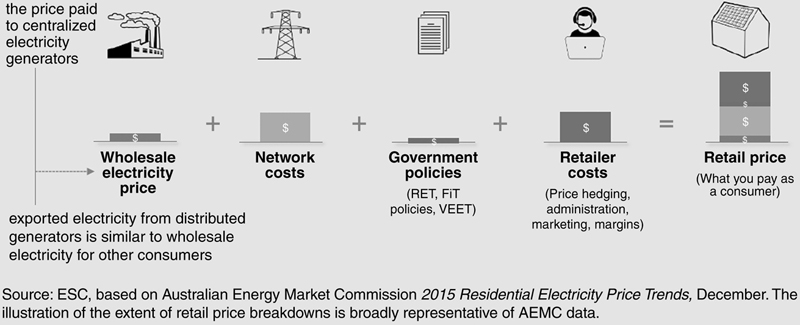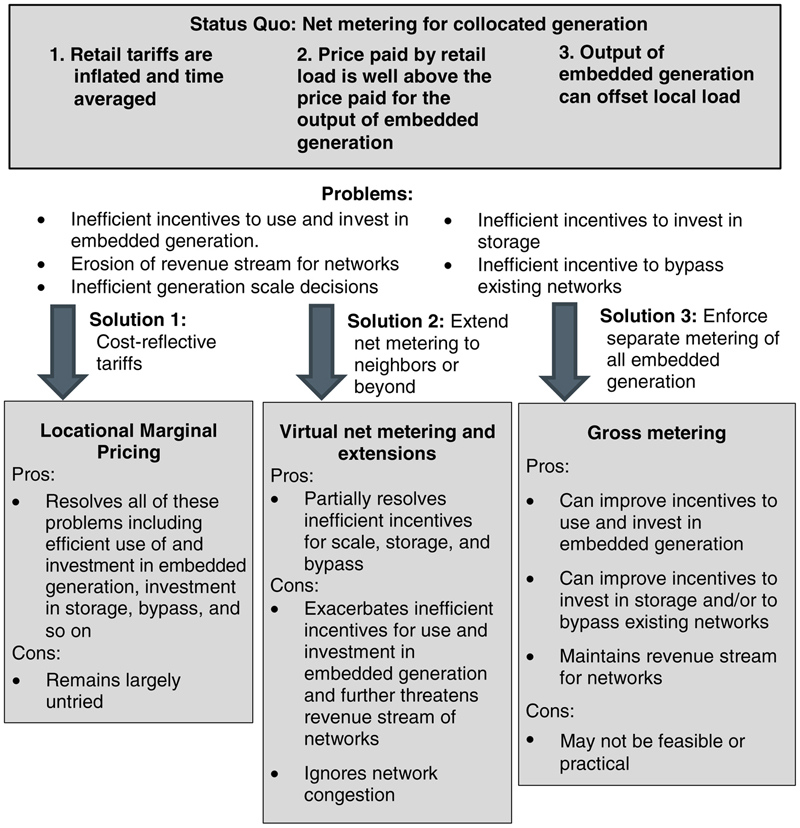Public Policy Issues Associated With Feed-In Tariffs and Net Metering: An Australian Perspective
Abstract
It has long been known that time-averaged and geographically averaged retail tariffs distort end-customer’s incentives to use and invest in appliances and energy efficiency. This problem is even more acute when end-customers can invest in and use on-site generation and storage. What tariff should be paid for the output of that generation or storage? Should the customer be able to use that output to offset his/her own consumption? Should the customer be able to sell any surplus to neighbors at the local retail rate? This chapter shows that with current retail tariffs, these policies have both pros and cons. Net metering and peer-to-peer trade will remain controversial as long as retail tariffs are not cost reflective.
Keywords
1. Introduction
2. Efficient tariffs for generation and load in theory
3. Retail tariffs for generation and load in practice, and their implications
3.1. Existing Retail Tariffs for Loads

FiT, Feed-in tariff; RET, Renewable Energy Target; VEET, Victorian Energy Efficiency Target.

ACT, Australian Capital Territory; NSW, New South Wales; QLD, Queensland; SA, Southern Australia; Tas, Tasmania; Vic, Victoria; WA, Western Australia.
3.2. Implications of Differences in the Tariff for Generation and the Tariff for Load
Table 10.1
Differences in Prices for Generation and Load Affects Incentives of End-Customers
| Case | Incentive |
| Generation price below load price | Generation seeks to combine with load, using net metering, colocation, or the creation of a duplicate physical network (such as an embedded network or microgrid) |
| Generation price above load price | Generation seeks to separate from load using gross metering, separate location, or diversion of load to masquerade as increased generation |
4. Current problems and possible future directions
4.1. The Status Quo and its Problems
4.2. Gross Metering, if it Were Feasible, Could Partially Solve These Problems
Table 10.2
Definitions of Gross and Net Metering
| Gross metering | The on-site generation and the on-site load are separately identified and metered, from the first unit of output or consumption in the same way as would arise if the generation and load were located on separate sites |
| Net metering | The on-site generation is required to be offset against on-site load at the same point in time. Net imports to the site are charged at the standard retail tariff for that point in time. If there are net exports from the site, the amount paid depends on the form of net metering which is discussed further below |

What the Queensland Competition Authority has proposed is the equivalent of telling people they can’t just use the lemons growing on the lemon tree in their backyard – they have to sell the produce to a wholesaler for next to nothing, and then buy the lemons back at a premium from the supermarket.18
4.3. Extended Forms of Net Metering Could Also Partially Solve These Problems, but Each has Problems of its Own
Table 10.3
Definitions Net Metering Used in This Chapter
| On-site net metering | The on-site generation is only allowed to be offset against on-site load, as long as there are no net exports from the site. Net imports to the site are charged at the standard retail tariff. If there are net exports from the site, the amount of the net export is paid the feed-in tariff. This form of net metering is standard in Australia |
| Virtual net metering | On-site generation is allowed to be offset against on-site load and other designated loads in a designated neighborhood at the same point in time, such as the participants in a community-shared solar scheme. Other net exports are paid the feed-in tariff |
| Local or community net metering | On-site generation is allowed to be offset against all load in a designated site, campus or neighborhood at the same point in time, such as a shopping center or housing subdivision |
| Global net metering | On-site generation is allowed to be offset against all loads at the same point in time |

